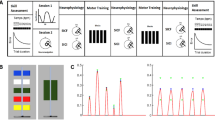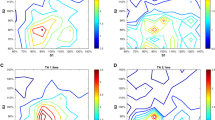Abstract
The motor-evoked potential (MEP) to transcranial magnetic stimulation (TMS) is inhibited when preceded by a subthreshold TMS stimulus at short intervals (1–6 ms; intracortical inhibition, ICI) and is facilitated when preceded by a subthreshold TMS at longer intervals (10–15 ms; intracortical facilitation, ICF). We studied changes in ICI and ICF associated with two motor tasks requiring a different selectivity in fine motor control of small hand muscles (abductor pollicis brevis muscle, APB, and fourth dorsal interosseous muscle, 4DIO). In experiment 1 (exp. 1), nine healthy subjects completed four sets (5 min duration each) of repetitive (1 Hz) thumb movements. In experiment 2 (exp. 2), the subjects produced the same number of thumb movements, but complete relaxation of 4DIO was demanded. Following free thumb movements (exp. 1), amplitudes of MEPs in response to both single and paired TMS showed a trend to increase with the number of exercise sets in both APB and 4DIO. By contrast, more focal, selective thumb movementsinvolving APB with relaxation of 4DIO (exp. 2) caused an increase in MEP amplitudes after single and paired pulses only in APB, while a marked decrease in MEPs after paired pulses, but not after single TMS, in the actively relaxed 4DIO. This effect was more prominent for the interstimulus interval (ISI) of 1–3 ms than for longer ISIs (8 ms, 10 ms, and 15 ms). F-wave amplitudes reflecting excitability of the alpha motoneuron pool were unaltered in APB and 4DIO, suggesting a supraspinal origin for the observed changes. We conclude that plastic changes of ICI and ICF within the hand representation vary according to the selective requirements of the motor program. Performance of more focal tasks may be associated with a decrease in ICI in muscles engaged in the training task, while at the same time ICI may be increased in an actively relaxed muscle, also required for a focal performance. Additionally, our data further supports the idea that ICI and ICF may be controlled independently.
Similar content being viewed by others
Author information
Authors and Affiliations
Additional information
Received: 20 September 1996 / Accepted: 1 October 1997
Rights and permissions
About this article
Cite this article
Liepert, J., Classen, J., Cohen, L. et al. Task-dependent changes of intracortical inhibition. Exp Brain Res 118, 421–426 (1998). https://doi.org/10.1007/s002210050296
Issue Date:
DOI: https://doi.org/10.1007/s002210050296




